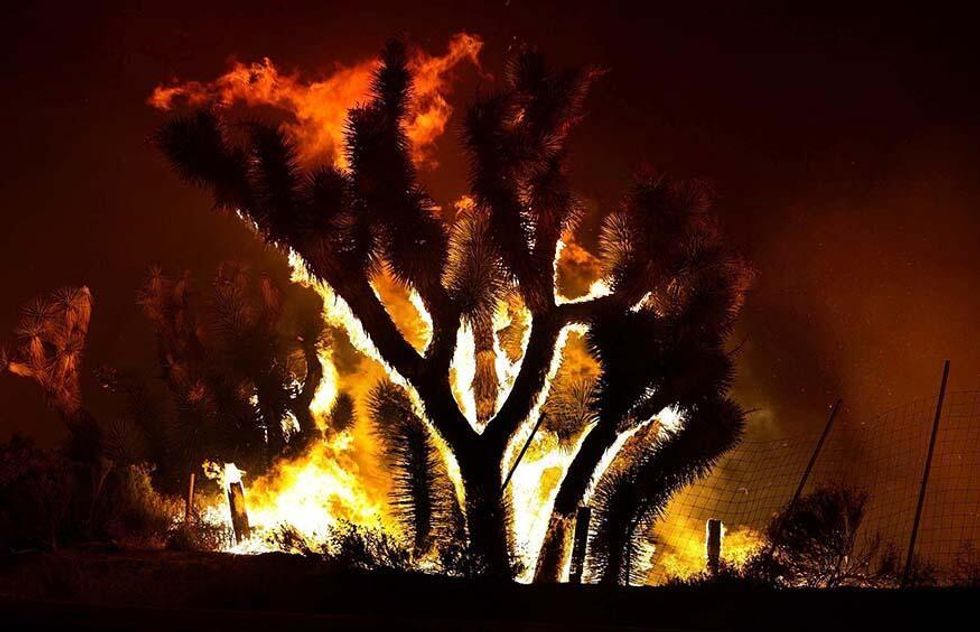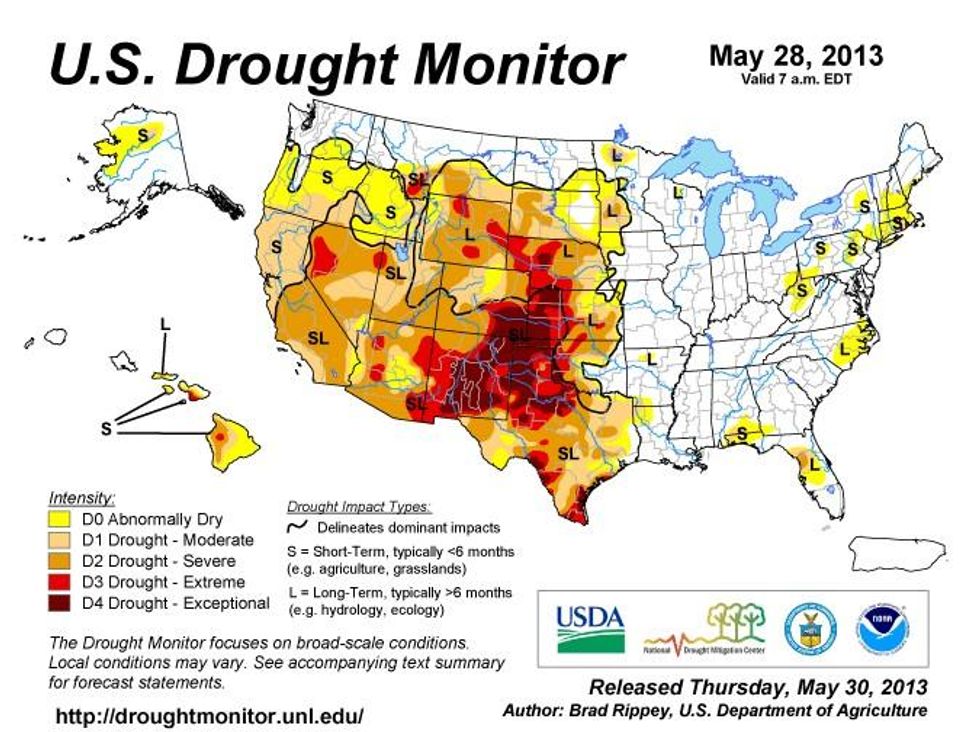

SUBSCRIBE TO OUR FREE NEWSLETTER
Daily news & progressive opinion—funded by the people, not the corporations—delivered straight to your inbox.
5
#000000
#FFFFFF
To donate by check, phone, or other method, see our More Ways to Give page.


Daily news & progressive opinion—funded by the people, not the corporations—delivered straight to your inbox.

In testimony to the Senate Energy and Natural Resources Committee, U.S. Forest Service Chief Thomas Tidwell said:
Around the world, the last two decades have seen fires that are extraordinary in their size, intensity and impacts. In Australia in 2009, the Black Saturday Bushfires killed 170 people. Domestically, Florida, Georgia, Utah, California, Texas, Arizona, New Mexico and Colorado, have all experienced the largest and/or the most destructive fires in their history just in the last six years. On average wildfires burn twice as many acres each year as compared to 40 years ago, and there are on average seven times as many fires over 10,000 acres per year.
In 2012 over 9.3 million acres burned in the United States. The fires of 2012 were massive in size, with 51 fires exceeding 40,000 acres. Of these large fires, 14 exceeded 100,000 acres. The increase in large fires in the west coincides with an increase in temperatures and early snow melt in recent years. This means longer fire seasons. The length of the fire season has increased by over two months since the 1970s.
"The largest issue we now face is how to adapt our management to anticipate climate change impacts and to mitigate their potential effects," Tidwell told the committee.
Illustrating how climate change has quickly impacted on wildfires, Tidwell told the Guardian, "Ten years ago in New Mexico outside Los Alamos we had a fire get started. Over seven days, it burned 40,000 acres. In 2011, we had another fire. Las Conchas. It also burned 40,000 acres. It did it in 12 hours."
Last week, Santa Barbara County fire Capt. David Sadecki said of the White Fire that burned nearly 2,000 acres in southern California, "It's still spring--it's not even summer--and it's burning like it's August or September."
These increasingly severe wildfires have a monetary effect as well. Fire activities represented 13 percent of the U.S. Forest Service's total agency budget in 1991, but that figure jumped to over 40 percent in 2012.
In the most recent wildfire potential outlook released June 1 by the National Interagency Fire Center, warmer, drier than usual conditions are contributing to above normal potential for wildfires in large swathes of the west. And the most recent drought monitor shows dry conditions plaguing much of the western half of the country.

________________________
Political revenge. Mass deportations. Project 2025. Unfathomable corruption. Attacks on Social Security, Medicare, and Medicaid. Pardons for insurrectionists. An all-out assault on democracy. Republicans in Congress are scrambling to give Trump broad new powers to strip the tax-exempt status of any nonprofit he doesn’t like by declaring it a “terrorist-supporting organization.” Trump has already begun filing lawsuits against news outlets that criticize him. At Common Dreams, we won’t back down, but we must get ready for whatever Trump and his thugs throw at us. As a people-powered nonprofit news outlet, we cover issues the corporate media never will, but we can only continue with our readers’ support. By donating today, please help us fight the dangers of a second Trump presidency. |

In testimony to the Senate Energy and Natural Resources Committee, U.S. Forest Service Chief Thomas Tidwell said:
Around the world, the last two decades have seen fires that are extraordinary in their size, intensity and impacts. In Australia in 2009, the Black Saturday Bushfires killed 170 people. Domestically, Florida, Georgia, Utah, California, Texas, Arizona, New Mexico and Colorado, have all experienced the largest and/or the most destructive fires in their history just in the last six years. On average wildfires burn twice as many acres each year as compared to 40 years ago, and there are on average seven times as many fires over 10,000 acres per year.
In 2012 over 9.3 million acres burned in the United States. The fires of 2012 were massive in size, with 51 fires exceeding 40,000 acres. Of these large fires, 14 exceeded 100,000 acres. The increase in large fires in the west coincides with an increase in temperatures and early snow melt in recent years. This means longer fire seasons. The length of the fire season has increased by over two months since the 1970s.
"The largest issue we now face is how to adapt our management to anticipate climate change impacts and to mitigate their potential effects," Tidwell told the committee.
Illustrating how climate change has quickly impacted on wildfires, Tidwell told the Guardian, "Ten years ago in New Mexico outside Los Alamos we had a fire get started. Over seven days, it burned 40,000 acres. In 2011, we had another fire. Las Conchas. It also burned 40,000 acres. It did it in 12 hours."
Last week, Santa Barbara County fire Capt. David Sadecki said of the White Fire that burned nearly 2,000 acres in southern California, "It's still spring--it's not even summer--and it's burning like it's August or September."
These increasingly severe wildfires have a monetary effect as well. Fire activities represented 13 percent of the U.S. Forest Service's total agency budget in 1991, but that figure jumped to over 40 percent in 2012.
In the most recent wildfire potential outlook released June 1 by the National Interagency Fire Center, warmer, drier than usual conditions are contributing to above normal potential for wildfires in large swathes of the west. And the most recent drought monitor shows dry conditions plaguing much of the western half of the country.

________________________

In testimony to the Senate Energy and Natural Resources Committee, U.S. Forest Service Chief Thomas Tidwell said:
Around the world, the last two decades have seen fires that are extraordinary in their size, intensity and impacts. In Australia in 2009, the Black Saturday Bushfires killed 170 people. Domestically, Florida, Georgia, Utah, California, Texas, Arizona, New Mexico and Colorado, have all experienced the largest and/or the most destructive fires in their history just in the last six years. On average wildfires burn twice as many acres each year as compared to 40 years ago, and there are on average seven times as many fires over 10,000 acres per year.
In 2012 over 9.3 million acres burned in the United States. The fires of 2012 were massive in size, with 51 fires exceeding 40,000 acres. Of these large fires, 14 exceeded 100,000 acres. The increase in large fires in the west coincides with an increase in temperatures and early snow melt in recent years. This means longer fire seasons. The length of the fire season has increased by over two months since the 1970s.
"The largest issue we now face is how to adapt our management to anticipate climate change impacts and to mitigate their potential effects," Tidwell told the committee.
Illustrating how climate change has quickly impacted on wildfires, Tidwell told the Guardian, "Ten years ago in New Mexico outside Los Alamos we had a fire get started. Over seven days, it burned 40,000 acres. In 2011, we had another fire. Las Conchas. It also burned 40,000 acres. It did it in 12 hours."
Last week, Santa Barbara County fire Capt. David Sadecki said of the White Fire that burned nearly 2,000 acres in southern California, "It's still spring--it's not even summer--and it's burning like it's August or September."
These increasingly severe wildfires have a monetary effect as well. Fire activities represented 13 percent of the U.S. Forest Service's total agency budget in 1991, but that figure jumped to over 40 percent in 2012.
In the most recent wildfire potential outlook released June 1 by the National Interagency Fire Center, warmer, drier than usual conditions are contributing to above normal potential for wildfires in large swathes of the west. And the most recent drought monitor shows dry conditions plaguing much of the western half of the country.

________________________